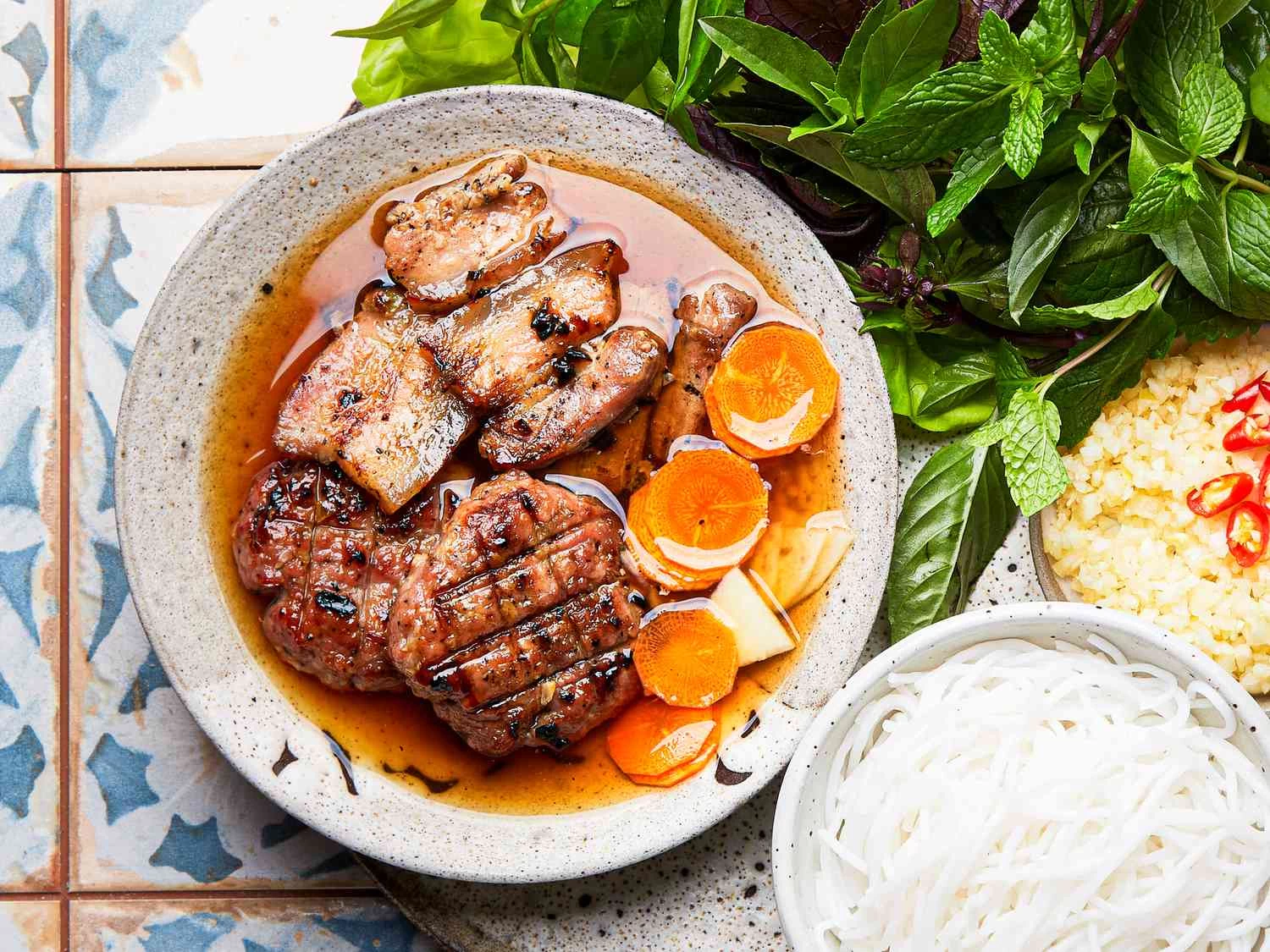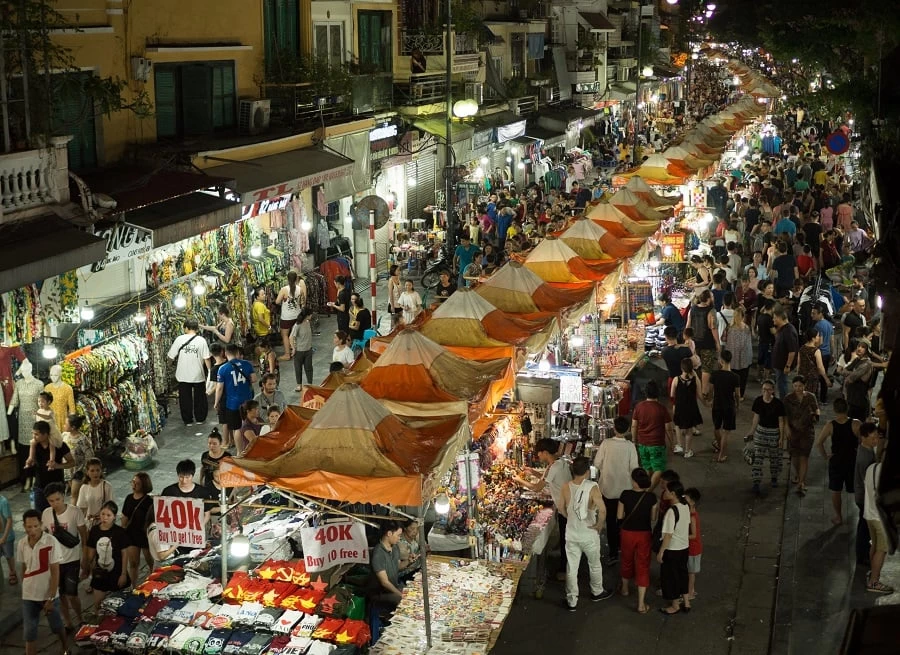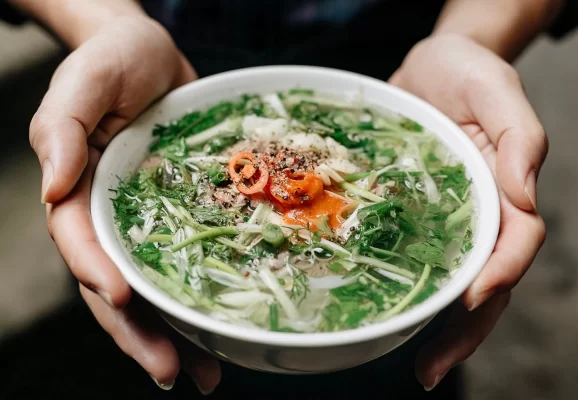
Pho Hanoi and the 5 best places to try.
Discover the authentic taste of “Pho Hanoi,” Vietnam’s iconic noodle soup, right in the heart of Hanoi. This rich and aromatic dish is celebrated for its flavorful beef or chicken broth, tender noodles, and fresh herbs. Explore the history and cultural significance of pho, find out where to enjoy the best bowls in Hanoi, and learn how to savor this traditional delicacy like a local. Whether you’re a food enthusiast or a curious traveler, “Pho Hanoi” offers an unforgettable culinary experience that embodies the essence of Vietnamese cuisine.
Do not miss: Hanoi Cuisine: The Top 10 Unique Flavors
I. Introduction to Pho Hanoi
1. Overview of Pho Hanoi
Pho Hanoi, a renowned Vietnamese dish, is a flavorful and aromatic noodle soup that has captivated taste buds both locally and internationally. This traditional delicacy features a delicate broth simmered with beef or chicken, infused with a blend of spices, and served with rice noodles and an array of fresh herbs and vegetables. Often enjoyed as a hearty breakfast or a satisfying meal throughout the day, Pho Hanoi represents a quintessential experience in Vietnamese cuisine.
2. History of Pho Hanoi
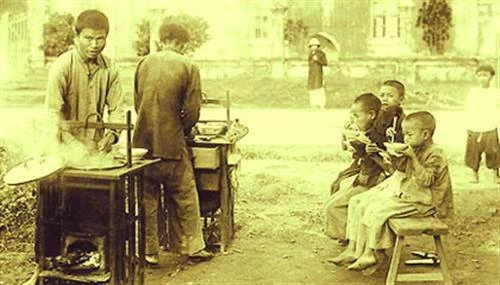
History of Pho
The origins of Pho can be traced back to the early 20th century in Hanoi, the capital of Vietnam. The dish is believed to have evolved from a fusion of local and French culinary influences during the colonial period.
It is thought that Pho was inspired by the French beef stew “pot-au-feu,” which was adapted to suit Vietnamese tastes by incorporating local ingredients and spices. Over time, Pho Hanoi evolved into the flavorful and aromatic dish we know today, gaining popularity across Vietnam and eventually around the world.
The development of Pho Hanoi reflects the city’s rich cultural and historical heritage. The dish became a symbol of Hanoi’s vibrant street food culture, with numerous vendors and restaurants specializing in Pho. Its evolution has been influenced by various regional ingredients and techniques, contributing to its unique taste and character.
3. Importance of Pho Hanoi in Vietnamese Cuisine
Pho is not merely a dish but a cultural icon in Vietnamese cuisine, especially in Hanoi. It holds a special place in the hearts of locals and visitors alike, representing the essence of Vietnamese culinary traditions. The importance of Pho Hanoi extends beyond its taste; it embodies the spirit of communal eating and the rich history of Vietnam.
In Hanoi, Pho is more than just food; it’s a daily ritual and a source of pride. The dish is often enjoyed in bustling street-side eateries, where locals and tourists gather to savor its rich flavors and aromatic broth. Pho also plays a significant role in celebrations and social gatherings, reflecting its deep-rooted connection to Vietnamese culture.
Moreover, Pho Hanoi has gained international recognition, contributing to Vietnam’s global culinary reputation. Its distinct flavor profile and cultural significance have made it a popular choice among food enthusiasts worldwide. As a result, Pho Hanoi continues to be a symbol of Vietnam’s vibrant food culture and a must-try experience for anyone visiting the country.
Do not miss: Hanoi Day Trip
II. Famous Types of Pho Hanoi
Hanoi is renowned for its diverse and flavorful pho offerings. Here’s a detailed look at some of the most popular types of pho you can find in the city:
1. Pho Bo (Beef Pho)
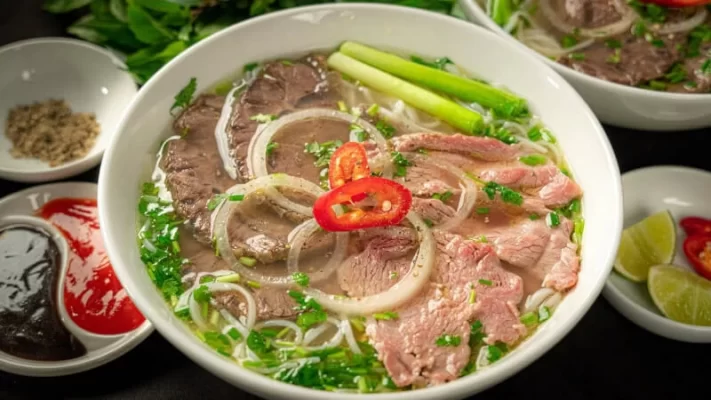
Beef Pho
Pho Bo is the quintessential version of pho that many people associate with Vietnamese cuisine. It comes in several variations, each with its own unique flavor and preparation method:
- Pho Bo Tai (Rare Beef Pho): This variation is characterized by its use of thinly sliced raw beef that is briefly cooked by the hot broth poured over it. The beef remains tender and slightly pink in the center. The broth, usually made from simmered beef bones, is rich and flavorful. Pho Bo Tai is often served with fresh herbs, bean sprouts, lime, and chili for added freshness and spiciness.
- Pho Bo Chin (Well-Done Beef Pho): In contrast to Pho Bo Tai, Pho Bo Chin features well-cooked beef that is typically simmered until tender. The beef is cut into chunks or slices and is cooked directly in the broth. This version has a heartier texture and a more robust flavor due to the longer cooking time. It is often paired with the same fresh herbs and condiments as Pho Bo Tai.
Click here: Private Street Food Tour Hanoi by Walking in 3 Hours
2. Pho Ga (Chicken Pho)
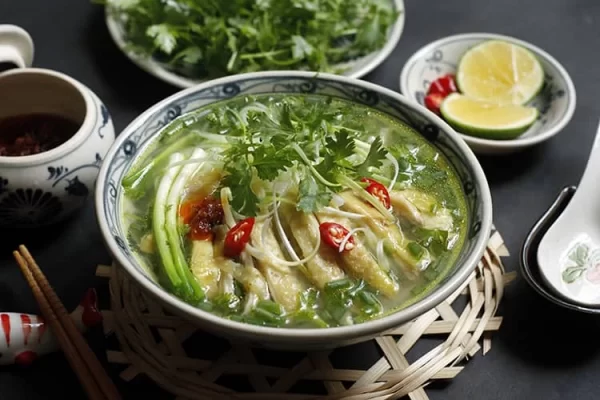
Chicken Pho
Pho Ga is a delicious alternative to beef pho and is celebrated for its lighter, more delicate flavors. Here’s what sets it apart:
- Ingredients: Pho Ga is made with chicken, which can be prepared in various ways, such as boiled, roasted, or even grilled. The broth is typically clear and aromatic, made from simmering chicken bones, and sometimes enhanced with herbs and spices like ginger, garlic, and star anise.
- Preparation: The chicken is usually shredded or served in chunks, and the broth is less rich compared to Pho Bo, resulting in a lighter and more subtle flavor. Fresh herbs such as cilantro and mint, as well as lime and chili, are often added to enhance the taste.
- Differences from Pho Bo: Unlike Pho Bo, which has a strong beef flavor, Pho Ga has a more subtle and clean taste due to the chicken. The broth is also usually clearer and less fatty, making it a lighter option for those who prefer a less intense flavor.
Do not miss: Hanoi Cooking Classes
III. How to Enjoy Pho Hanoi
1. How to Eat Pho Hanoi
Eating pho correctly involves more than just eating noodles and broth; it’s an experience that engages all your senses. Here’s how to enjoy this iconic Vietnamese dish in the traditional manner:
- Start with the Broth: Begin by tasting the broth alone. This allows you to appreciate the depth of flavors achieved through the long simmering of beef bones, spices, and herbs. Savor its rich, aromatic taste before adding any additional ingredients.
- Mix Ingredients: After the initial taste, use your chopsticks to mix the noodles, meat, and herbs in the bowl. This helps to ensure that each bite is well-balanced and flavorful. You may also use the provided spoon to stir the ingredients thoroughly.
- Add Condiments to Taste: Adjust the flavor to your preference by adding condiments such as lime juice, chili slices, and fish sauce. This personalizes the pho to suit your taste.
- Savor Each Bite: Take your time to enjoy the different textures and flavors. The noodles should be tender but still have a slight bite, the meat should be succulent, and the herbs should provide freshness.
- Finish with Broth: Once you’ve enjoyed the noodles and meat, you can sip the remaining broth directly from the bowl or use the spoon to savor the last of it. The broth is the heart of the dish, reflecting the essence of traditional pho.
2. Common Accompaniments
Pho is typically served with a variety of fresh ingredients and condiments that enhance its flavor. Here are the most common accompaniments:
- Bean Sprouts: Bean sprouts add a crunchy texture and a fresh, slightly sweet flavor. They are often added to the pho either directly in the bowl or on the side, allowing you to mix them in according to your taste.
- Herbs: Fresh herbs such as basil, cilantro, and mint are standard accompaniments. These herbs add a fragrant and refreshing note to the dish. Tear the leaves and mix them into the pho to release their aromatic oils.
- Lime: Lime wedges are provided for a burst of acidity. Squeeze a wedge over your pho to add a tangy flavor that brightens up the dish and balances the richness of the broth.
- Chili Peppers: Sliced fresh or pickled chili peppers are available for those who enjoy a bit of heat. Add them to the pho according to your spice preference to give the dish a fiery kick.
- Fish Sauce: This fermented fish sauce is used to enhance the umami flavor of the pho. It’s usually added sparingly, as it is quite salty and potent. Drizzle a small amount to add depth to the broth.
2. When is the best time to enjoy Pho Hanoi?
Pho Hanoi is available year-round and suitable for any meal, even with late-night cravings. Experts claim that pho bo chin, which consists of perfectly cooked beef in a broth of rice noodles, perfectly captures the spirit of Hanoi’s culture. The carefully prepared stock, which is made from beef bones flavored with a variety of spices and is the key to its perfection, is cooked for a clear, naturally sweet aroma.
IV. Best Pho Hanoi Restaurants
Now, let’s transition to the focal point: the top Hanoi Pho. Presented here are renowned dining destinations in the city, each offering its own unique array of flavors and specialties!
1. Pho Tu Lun
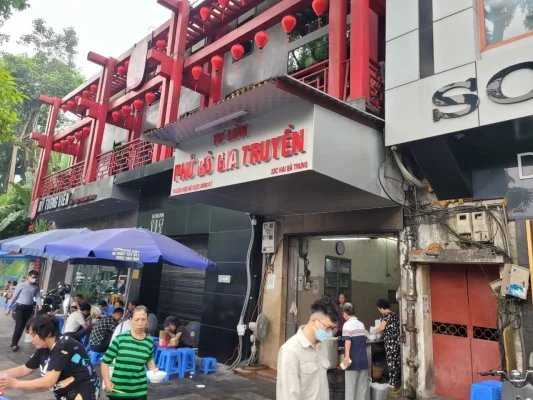
Pho Tu Lun
Pho Tu Lun sits conveniently on Hai Ba Trung Street, just a short stroll from the Hanoi Old Quarter. Should you find yourself in Hanoi and happen to stay nearby, missing out on the opportunity to visit this remarkable gem would be a decision you’d regret deeply. At Pho Tu Lun, locals from the Old Quarter consistently praise the pho, known for satisfying even the heartiest appetites among its patrons.
The broth is very flavorful and somewhat fatty; the noodles are soft; and the bowl also has a lot of onions. Savoring a mouthful of pho with tender minced beef in its savory broth promises an unforgettable culinary experience. Additionally, Pho Tu Lun has earned acclaim by Michelin standards. If you find yourself in Hanoi, it’s highly recommended that you visit and savor the experience firsthand.
- Address: 23c Hai Ba Trung, Hoan Kiem District, Hanoi, Vietnam.
- Opening time: 6am – 7pm.
2. Pho Bat Dan
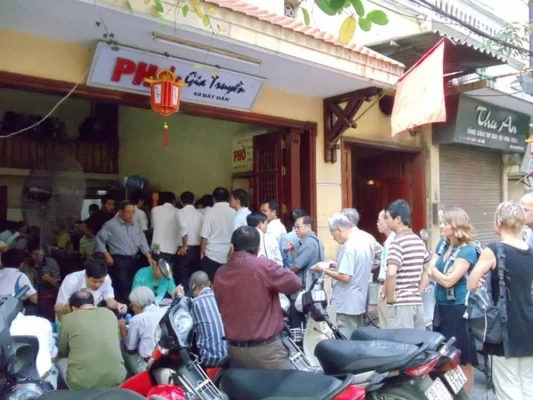
Pho Bat Dan
Having stood for almost seven decades, Pho Bat Dan has not only earned its reputation for exceptional pho but has also become renowned for its unique queuing culture, which has endured for decades and became a cultural phenomenon during the ’80s.
Inside Pho Bat Dan, the beef is impeccably fresh, cooked to perfection, and expertly sliced. The broth, infused with sweetness from meticulously stewed beef bones, embodies the essence of an authentic bowl of Hanoi pho, making Pho Bat Dan a must-visit destination for any pho enthusiast.
- Address: 49 Bat Dan, Cua Dong, Hoan Kiem District, Hanoi, Vietnam.
- Opening time: From 6am to 10am, 6pm – 8.30pm.
3. Pho 10 Ly Quoc Su
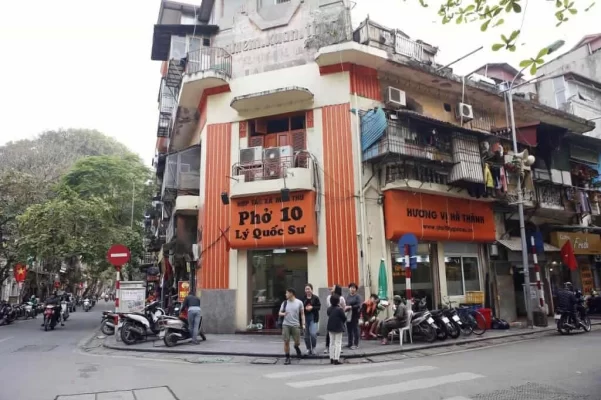
Pho 10 Ly Quoc Su
Pho 10 Ly Quoc Su, situated in the heart of Hanoi, enjoys widespread acclaim from local food enthusiasts as the premier Pho establishment in the city. Located at 10 Ly Quoc Su Street, the restaurant boasts a diverse menu catering to all palates, offering options ranging from well-done to rare steak and heel muscle. This specialty is renowned for its delectable taste and diverse selection, catering to meet every customer’s need.
What sets Pho Ly Quoc Su apart is its richly flavorful broth, crafted from carefully chosen ingredients that lend it an unmatched taste. While the broth takes center stage, the fresh and tender beef further elevates the dining experience, complemented perfectly by the crispy cruller sticks that accompany the piping hot bowl of noodles.
Pho 10 Ly Quoc Su also receives praise for its crunchy cruller sticks, which enhance the overall flavor profile of the steaming noodle dish. Rest assured, you won’t leave here hungry. This establishment is a must-visit destination in Hanoi!
- Address: 10 Ly Quoc Su, Hang Trong, Hoan Kiem District, Hanoi, Vietnam.
- Opening time: 6am to 2pm, 5.30pm – 10pm.
Learn more about: Hanoi Street Food
4. Pho Thin
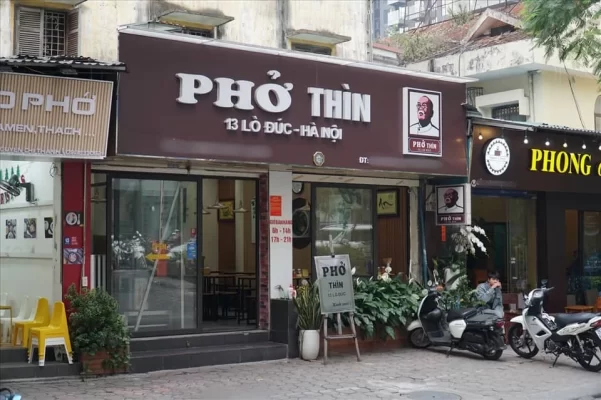
Pho Thin
This Hanoi specialty served at Thin diverges from tradition. Unlike the classic known for its delicate, lean broth and perfectly cooked beef, Thin takes a unique approach. Their rendition surprises with a generous topping of green spring onions covering the bowl’s surface, beef stir-fried instead of simmered, and a noticeably fatty broth due to this cooking method. This results in a broth that’s smokier, slightly sweeter, and richer.
For those accustomed to the traditional taste of Pho, Pho Thin‘s unconventional style might be perplexing. However, its popularity as one of favorite Hanoi Pho spots can be attributed to its unique characteristics.
Diners rave about the abundance of spring onions and the rich, fatty soup. Despite its indulgent nature, the dish manages to avoid being overwhelming, thanks to the balancing presence of the spring onions. Add a splash of garlic vinegar, and you’re in for a flavorful experience!
- Address: 13 Lo Duc, Hoan Kiem District, Hanoi, Vietnam.
- Opening time: From 6am to 8.30pm.
5. Pho Railway
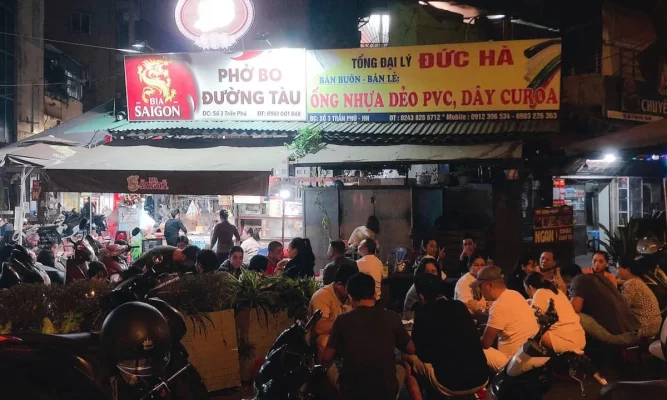
Pho Railway
Eating street-side is quintessentially Vietnamese, as it often leads to discovering some of the best culinary delights. Located near Hoan Kiem Lake at 03 Tran Phu Street, a humble bowl of Pho exemplifies this tradition. Here, there’s no formal establishment, just the tiniest stools and tables imaginable.
Operating from the afternoon till the wee hours of the morning, these street vendors attract not only regular locals but also curious passersby seeking a dinner or night snack. When visiting this unique Pho spot, don’t miss out on their beef stew Pho.
The tender, flavorful beef, slow-cooked for hours and the rich broth, promise an unforgettable culinary experience. And what could be more satisfying than indulging in a steaming bowl of Pho on a chilly night? Don’t wait any longer; give it a try now.
- Address: 3 Tran Phu, Hoan Kiem District, Hanoi, Vietnam.
- Opening time: From 6pm to 4am.
V. Tips for Finding the Best Pho Hanoi Restaurants
- Check Reviews: Look for online reviews on platforms like TripAdvisor, Google Maps, or food blogs. Positive reviews from other travelers and locals can be a good indicator of quality.
- Word of Mouth: Ask locals or other travelers for recommendations. Personal experiences often provide the best insights.
- Traditional Recipes: Opt for places that use traditional recipes and cooking methods. Authentic pho restaurants will typically serve dishes made from scratch, including the broth, which should be simmered for hours to develop a rich flavor.
- Ingredients: Ensure the restaurant uses fresh ingredients, especially the herbs and meat. Freshness significantly impacts the taste of pho.
- Cleanliness: The restaurant should maintain high hygiene standards. A clean environment reflects the quality and safety of the food.
- Comfortable Atmosphere: While street food stalls offer great Pho, some visitors may prefer a more comfortable setting. Choose a place where you feel comfortable dining, whether it’s a street-side stall or a more formal restaurant.
In summary, Pho Hanoi is more than just a dish; it is a vibrant representation of Hanoi’s rich cultural heritage and culinary excellence. Renowned for its delicate balance of flavors, aromatic broth, and diverse ingredients, Pho Hanoi offers an authentic taste of Vietnamese tradition that is cherished both locally and internationally. Whether you’re savoring a steaming bowl of Pho Bo (beef pho) with its tender slices of beef and fragrant herbs or enjoying a lighter bowl of Pho Ga (chicken pho), each variation provides a unique glimpse into Hanoi’s culinary artistry.
For international travelers, Pho Hanoi is an unforgettable highlight of any trip to Hanoi. Embrace the opportunity to enjoy this culinary masterpiece in its authentic setting, and let the flavors and stories of Pho Hanoi enhance your journey through Vietnam’s capital.
See more: Hanoi Travel Tips






